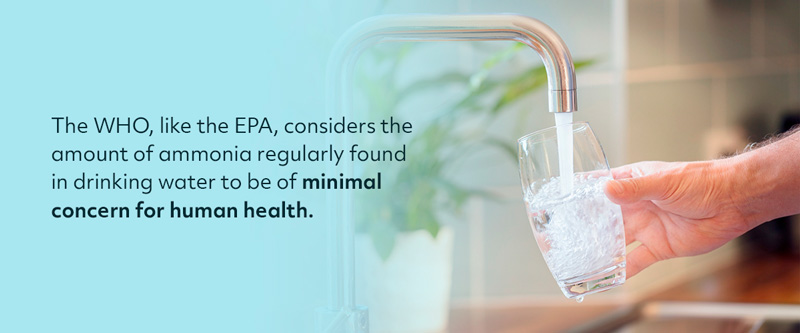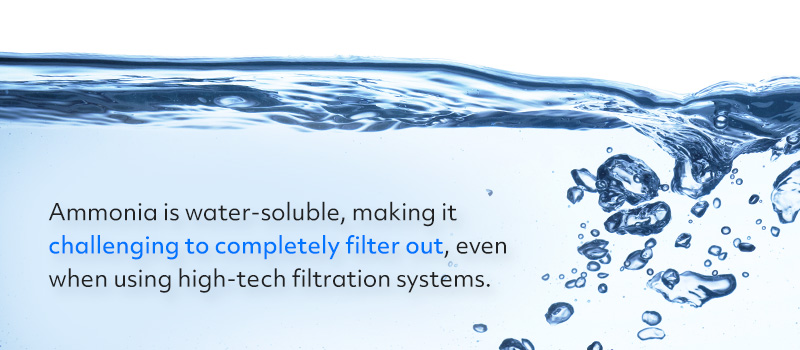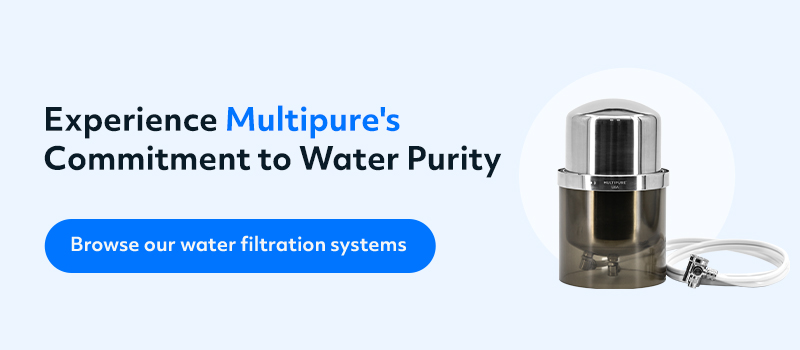Ammonia in Water: A Guide for Homeowners
Posted by Kenton Jones on Mar 4th 2024
Most of us recognize ammonia as a cleaning ingredient used to make our homes sparkling clean. But what about ammonia in our water supply? We wouldn't fill a glass of ammonia and drink it, so we probably don't want it coming out of our kitchen faucets either.
Is ammonia present in our drinking water? And if so, how does ammonia affect water quality? In this guide, we'll explain what ammonia is, how it can affect your water, how to detect it, and the types of contaminants water filtration systems can address to make your drinking water fresh and clean.
Contents In This Post:
The Environmental Impact of Ammonia In Water
How Does Ammonia Affect Water Quality
Is There Ammonia In Tap Water?
Health Implications of Ammonia In Drinking Water
Signs of High Ammonia Levels In Water
Can You Filter Ammonia From Drinking Water?
Invest In A Water Filtration System
Experience Multipure's Commitment To Water Purity
What Is Ammonia?
Ammonia (NH 3 or NH4+) is a chemical compound made of hydrogen and nitrogen. It is one of several forms of nitrogen that are present in many aquatic environments. It is a colorless, strong-smelling gas, and it is highly soluble in water – meaning it dissolves easily. Ammonia is found in:
- Nature: Ammonia can be found in most water sources as a byproduct of organic decomposition processes, especially the decomposition of proteins, which contain nitrogen. For example, the decomposition of a deer or squirrel carcass in the forest produces some ammonia — and so does the decay of a fallen tree. Most ammonia in the soil accrues as bacteria break down organic matter. Forest fires, human and animal waste, nitrogen fixation processes, and gas exchange with the atmosphere can also result in the formation of ammonia.
- The human body:Estimates suggest the average adult consumes 18 milligrams of ammonia a day with no ill effects. Since ammonia is a natural product of the breakdown of protein, ammonia is also produced daily in our bodies as we digest proteins. We then excrete the ammonia in our urine.
- Household cleaning solutions: Many glass, floor, and counter cleaners have an ammonia base.
- Fertilizer: About 70% of the ammonia produced industriallygoes into fertilizer. Ammonia is also a component of human and animal waste and is responsible for the strong, sharp odor associated with diapers, feedlots, and other places where urine and fecal matter are found.
Ammonia exists in either one of two forms. It can exist in a pure, un-ionized, uncharged form (NH3), or it can exist as a positively charged ammonium hydroxide ion (NH4+) when it dissolves in water. The form ammonia takes in water is highly dependent on the temperature and pH of the water. Warmer water will contain more of the un-ionized form and less of the ionized form than colder water, as will water with a higher, less acidic pH.
The un-ionized form of ammonia is the one that can be toxic to some forms of life. The ammonium ion does not have the same toxic properties.
The Environmental Impact of Ammonia in Water
High levels of ammonia in water can have a significant environmental impact.
So, what causes high ammonia levels in water? Ammonia in water primarily occurs due to agricultural fertilizers and industrial process wastes containing ammonia getting into surface water in runoff.
And what is the normal level of ammonia in water? According to the World Health Organization (WHO), the natural levels of ammonia in groundwater are typically below 0.2 milligrams per liter, sometimes written 0.2 parts per million (ppm). Higher natural levels of up to three milligrams per liter, though, are often found in forests or areas with substantial iron deposits. Surface waters may naturally contain up to 12 milligrams per liter. Higher levels than these can disrupt delicate aquatic ecosystems.
High ammonia levels can affect the environment in the following ways:Toxicity of Ammonia and Ammonium
In water, some ammonia breaks down to form the ammonium ion plus hydroxide ions. Ammonia is toxic to aquatic life, but ammonium ions are not. Generally, in water, an equilibrium exists between these two types of ammonia, and molecules change back and forth between the two states depending on pH and water temperatures.
At the acidic pH of 6, for instance, the ratio of ammonia to ammonium is about 1 to 3,000. At the basic pH of 8, that ratio declines sharply to 1 to 30. Warm water also tends to contain more toxic ammonia than cooler water.
Disruptions in Aquatic Ecosystems
Ammonia in water is non-toxic to humans, but it is toxic to aquatic life. Unlike other forms of nitrogen, which can indirectly harm aquatic ecosystems by increasing nutrient levels and promoting algae growth in the process known as eutrophication, ammonia has direct toxic effects on aquatic ecosystems.
Aquatic plants can absorb ammonia and incorporate it into some of the molecules of their structures, such as proteins and amino acids. Once aquatic organisms have absorbed it, it is challenging for them to excrete ammonia from their systems. It tends to build up in their tissues and blood until it kills them. For example, freshwater unionid mussels are highly sensitive to ammonia in water, as are freshwater gill-breathing snail species, along with many other invertebrates, fish, and plants.
Additionally, high levels of ammonia in lakes and streams can promote the growth of algae, which in turn can choke out the growth of other aquatic plants. Bacteria can also convert ammonia in water to nitrate in a process known as nitrification. Nitrification is a beneficial process if it takes place in the soil — plants can use the produced nitrates as food. However, nitrification tends to lower the dissolved oxygen levels in water, making it harder for fish and other aquatic life to breathe.

How Does Ammonia Affect Water Quality?
Ammonia in drinking water can sometimes create an unpleasant taste and smell, which is caused by the formation of chloramines, which the addition of ammonia helps promote. Chloramines form when both chlorine and ammonia are added to drinking water to disinfect it. However, ammonia is not thought to be toxic to human health at the levels found in drinking water.
Water that has become contaminated with fertilizer, chemical runoff, or animal waste may also contain increased levels of ammonia. Because of its lower toxicity to humans, the U.S. Environmental Protection Agency (EPA) has not set a standard upper limit for ammonia in public water sources. Local environmental limits for ammonia in drinking water throughout the United States range from 0.25 to 32.5 milligrams per liter.
The WHO, like the EPA, considers the amount of ammonia regularly found in drinking water to be of minimal concern for human health. For that reason, the WHO has not issued specific health-based guidelines for the levels of ammonia in drinking water.
Water Quality Recommendations for Ammonia
However, the EPA has established
recommended water quality criteria for total ammonia nitrogen (TAN) in water. These criteria are not law — they are guidelines that have the force of law only if states adopt them into their standard water quality criteria. Nevertheless, they remain helpful guidelines for determining safe ammonia levels. The EPA recommendations for ammonia include:
- Acute criterion magnitude: The EPA recommends a short-term concentration of only 17 milligrams TAN per liter of water, averaged over an hour with water at 20 degrees Celsius, and with a pH of 7. This limit should be exceeded, at most, once every three years.
- Chronic criterion magnitude: The EPA also recommends a long-term concentration of only 1.9 milligrams TAN per liter of water at the same temperature and pH as above, as measured over 30 days. This limit should also be exceeded, at most, once every three years.
- Four-day average: The EPA also recommends that the highest average concentration across four days within a 30-day timeframe should not exceed 4.8 TAN per liter of water more often than once every three years.
Associated Contaminants
High levels of ammonia in water are often indications of fecal contamination. In this case, the water may be contaminated with fertilizer or with fecal matter from nearby livestock. This scenario can cause the water to have an extremely unpleasant taste and smell. It can also increase the difficulty of disinfecting the water and thus increase the likelihood of waterborne illnesses.
Ammonia is also often found in water along with chlorine, which can impart an unpleasant taste and odor, dry out the skin, and potentially react with other contaminants to form carcinogenic substances.
Is There Ammonia in Tap Water?
Municipal water systems have been using ammonia as a drinking water treatment for over 70 years. It boosts and prolongs the beneficial effects of chlorine, which is widely added to municipal water supplies as a disinfectant.
When chlorine and ammonia are both added to drinking water, they react with each other to form chloramine. Most often, some part of the ammonia does not combine with the chlorine and remains in the water as free ammonia.
That free ammonia exists in different proportions of ammonia and ammonium, depending on factors like temperature and pH of the water. At a standard water temperature of 55 to 75 degrees Fahrenheit and a pH of between 7 and 7.8, 96% of the ammonia in drinking water is likely to be the ionized form of ammonium (NH4+). The other four percent is un-ionized ammonia.
Health Implications of Ammonia in Drinking Water
If extremely high levels of ammonia are present in drinking water, it can lead to ammonia poisoning if ingested. Long-term ingestion of water with a high ammonia concentration
harmful effects on the human body, including damage to organ systems. Specifically, an ammonia level of more than 1 mg can be dangerous to humans and animals.
The symptoms of ammonia poisoning include the following:
- Coughing, chest pain, wheezing, and difficulty breathing (if the person inhaled vapors).
- Fever
- Dizziness
- Ear, eye, nose, or throat pain and swelling
- Nausea
- Vomiting
- Confusion
- Shock
- Collapse and fainting
However, the usual levels of ammonia in drinking water are not high enough to cause these symptoms.
Signs of High Ammonia Levels in Water
Below are a few signs that may suggest high levels of ammonia in drinking water:
- Taste, odor, and particles in the water: An unpleasant taste and odor, along with particles in the water, can signify the presence of ammonia. Sometimes, this is because too much chlorine interacts with the ammonia, losing its disinfecting properties and allowing bacteria to thrive. A moldy, earthy taste can signify elevated concentrations of ammonia in drinking water. The moldy, earthy taste occurs when too much oxygen is filtered from the water in the nitrification process that occurs at elevated ammonia levels.
- Low chlorine levels: Low chlorine levels in water can indicate high levels of ammonia. If you happen to know the chlorine levels of your home's water, you can use these figures as a guide. Typically, drinking water that has a high ammonia level also has a significant difference between its chlorine levels and its total chlorine residual levels. A standard drinking water sample might have chlorine levels that range from 0.1 to 0.3 milligrams per liter but total chlorine levels that range from 1.2 to 1.5 milligrams per liter. This substantial difference suggests that something in the water is combining with the chlorine to form something else. That combining substance is usually ammonia.
- Lowered pH of the water: A decreased pH of the water you drink may also indicate the presence of ammonia. Water acidification — and the resulting lower pH — is often a consequence of nitrification and can indicate higher ammonia levels.
- Bacterial growth: Sometimes, the presence of ammonia in drinking water can lead to an overgrowth of bacteria that oxidize ammonia. These bacteria may form colonies on home water filters.
Can You Filter Ammonia From Drinking Water?
How do you get ammonia out of water if you suspect high levels? Ammonia is water-soluble, making it challenging to completely filter out, even when using high-tech filtration systems. Boiling your water can reduce the amounts of free ammonia, but it will not be effective against the ionized or dissolved forms.

Some reverse osmosis, ion exchange, or distillation systems may be effective for some ammonia reduction. But these systems are prohibitively expensive for many households to purchase and operate. The relatively low health risks associated with ammonia in drinking water make purchasing these expensive systems impractical for many homes — just as you wouldn't buy thousands of dollars of bug spray to kill a few ladybugs in your garden.
Fortunately, because the low levels of ammonia in drinking water are non-toxic to humans, filtering for ammonia is not necessary to make your water safe to drink.
And some of the harmful effects associated with ammonia levels — such as the presence of coliform bacteria caused by fertilizer or animal waste — are automatically filtered at municipal water facilities.
Water Filtration Methods
While normal levels of ammonia in drinking water treated in municipal facilities aren't always considered dangerous to health, there are some cases in which you might invest in water filtration systems to reduce ammonia and prevent adverse health effects. For example, you might want to learn how to filter ammonia from water if:
- You use well water: Since municipal water facilities don't supply well water, they can't filter it for contaminants associated with high ammonia levels, like coliform bacteria and fecal matter. If you have well water, your home is not protected from contaminants like waste, fertilizers, and the effects of natural decomposition processes that occur every day.
- You live in an agricultural area: Agricultural areas are more likely to have higher amounts of fertilizer runoff and fecal contamination from livestock.
- Your water has higher levels of chloramine: When ammonia interacts with chlorine, the two chemicals can form chloramine. In turn, chloramine and chlorine can interact with organic matter in drinking water to create disinfection byproducts (DBPs). The DBPs that chloramine produces include a possible carcinogen and toxic iodoacetic acid.
The following are a few water filtration methods that can help reduce ammonia in tap water:
Boiling Water
One way to reduce ammonia levels in drinking water is to boil it. Many use this method to get their water from unsafe to safe drinking conditions quickly. For instance, when people go camping, many plan to find natural water and boil it to make it safe to drink and use for other purposes, such as brushing their teeth.
However, boiling water cannot effectively remove 100% of ammonia in water. As mentioned, boiling can remove free ammonia, but it is ineffective against the ionized or dissolved forms of ammonia. For this reason, boiling is often only used as a short-term solution to reduce ammonia levels in water.
Distillation
Distillation is an effective method to reduce ammonia that relies on electricity and energy. Distillers come in air-cooled or water-cooled units. They work by boiling water, causing vapor and volatiles to escape. The water vapor is condensed to form liquid water, with a carbon filter often used to remove the ammonia and other contaminants that boil along with the water. After, the residue in the unit must be flushed to prevent buildup.
While effective, the cost of purchasing, installing, and operating a distillation system can make it unfeasible for many households. They are also time-consuming and produce flat-tasting water, since it doesn't contain healthy minerals.
Reverse Osmosis
Reverse osmosis is another water filtration method that requires a large and complex system. The process starts with a pre-filter through which water passes. The pre-filter removes particulates and pollutants before the water enters a high-pressure chamber. The chamber is lined with a semipermeable membrane that strains 98% of the remaining pollutants.
It also goes through an adsorption filter to improve the aesthetic qualities of the water, like taste, color, and odor. The water sits in a pressurized container, requiring a final filter to remove tastes associated with the pressure container.
Invest in a Water Filtration System
If you want to reduce the effects of chloramine caused by ammonia, you can invest in a water purifier, such as Multipure's Aqualuxe, to filter filter chloramine and other contaminants from your household's water. Aqualuxe reduces chloramine levels in water by over 97.5% and improves your drinking water's taste, odor, and overall quality. Aqualuxe also treats DBPs to protect you from potentially toxic byproducts of chloramine.
If you're concerned about other contaminants in your drinking water, a carbon block filter is a quality choice. Benefits of Multipure's solid carbon block filters include:
- Reduces over 85 contaminants to improve the healthfulness of your drinking water.
- Conforms to NSF/ANSI Standard 42 for proven chemical and contaminant reduction.
- Reduces levels of chloramine and contaminants like DBPs.
Experience Multipure's Commitment to Water Purity

Many other contaminants exist alongside ammonia in public water systems — chlorine, PFOs and PFOAs (forever chemicals), asbestos, lead, mercury, viruses, and bacteria, just to name a few. When you need a way to filter these contaminants from your home's water, trust Multipure.
For over 50 years, our drinking water systems have helped reduce contaminants and leave your drinking water fresh and clean. Our Aqualuxe system was one of the first to be certified under NSF Standard 53, effectively reducing harmful PFOAs and PFOs from water. Pair the Aqualuxe with our bath and garden help reduce the amount of chlorine in your bath, shower, and on-the-go water, as well as providing a whole-house filtration option.
Contact us today to learn more.

